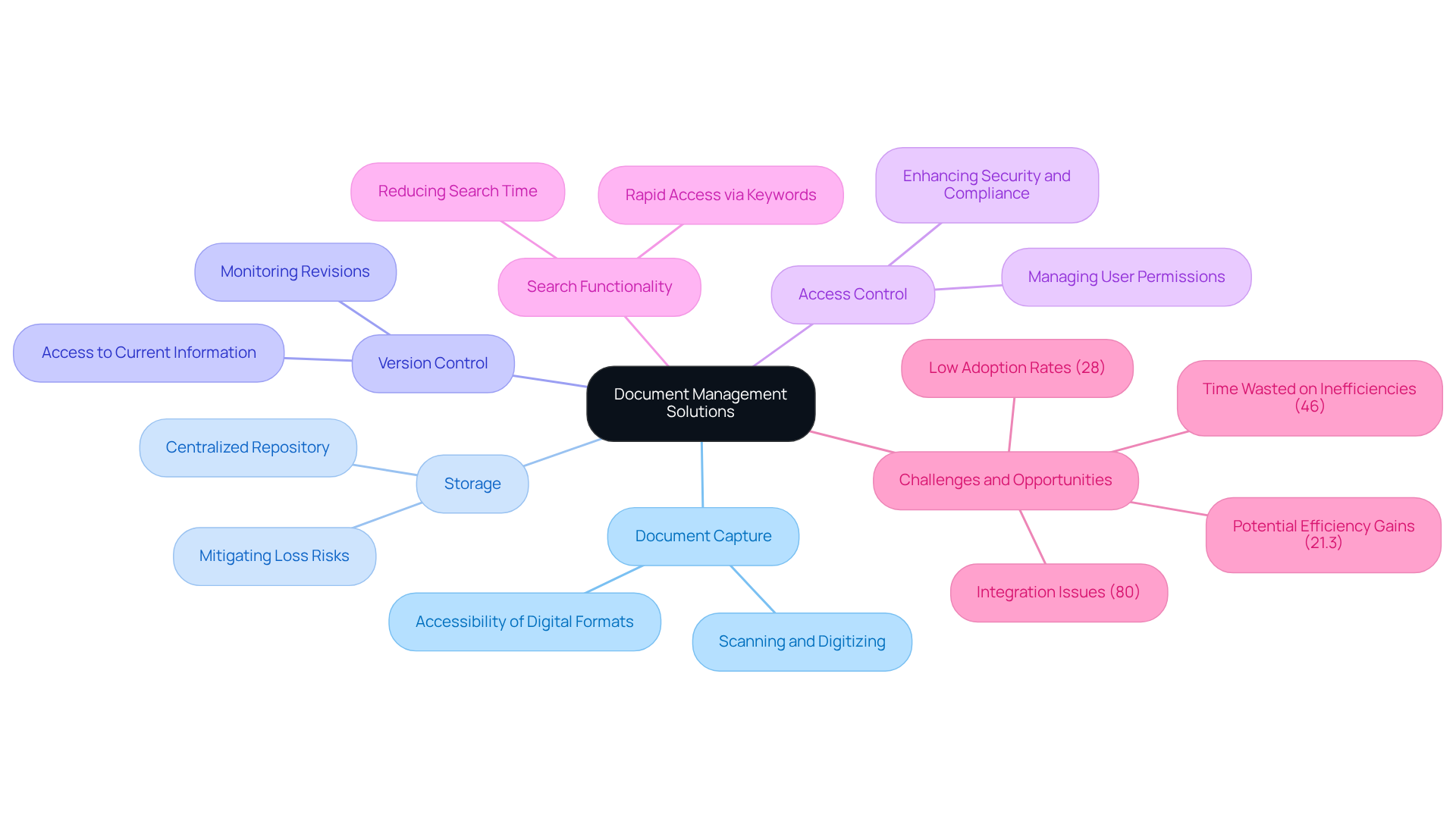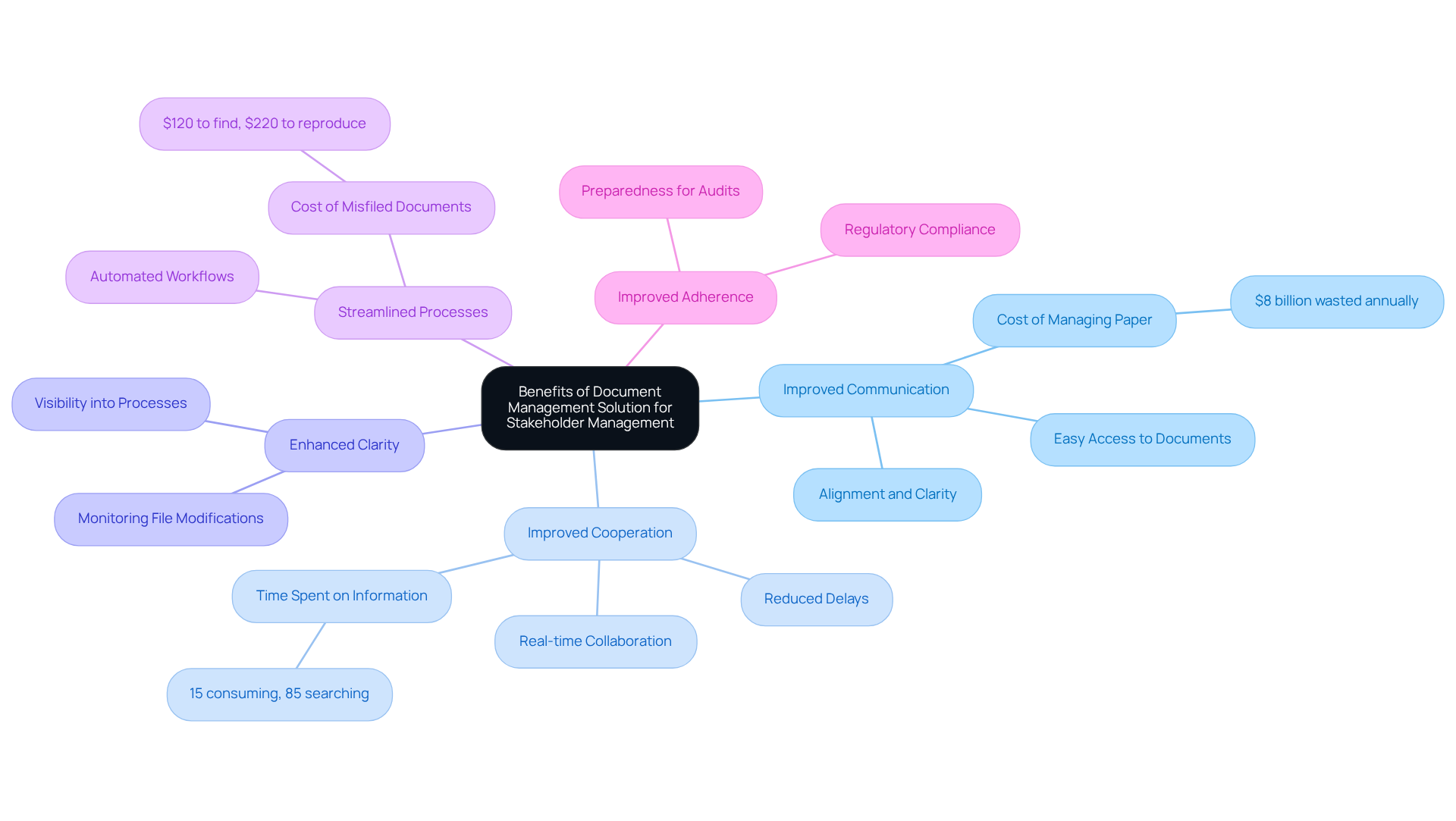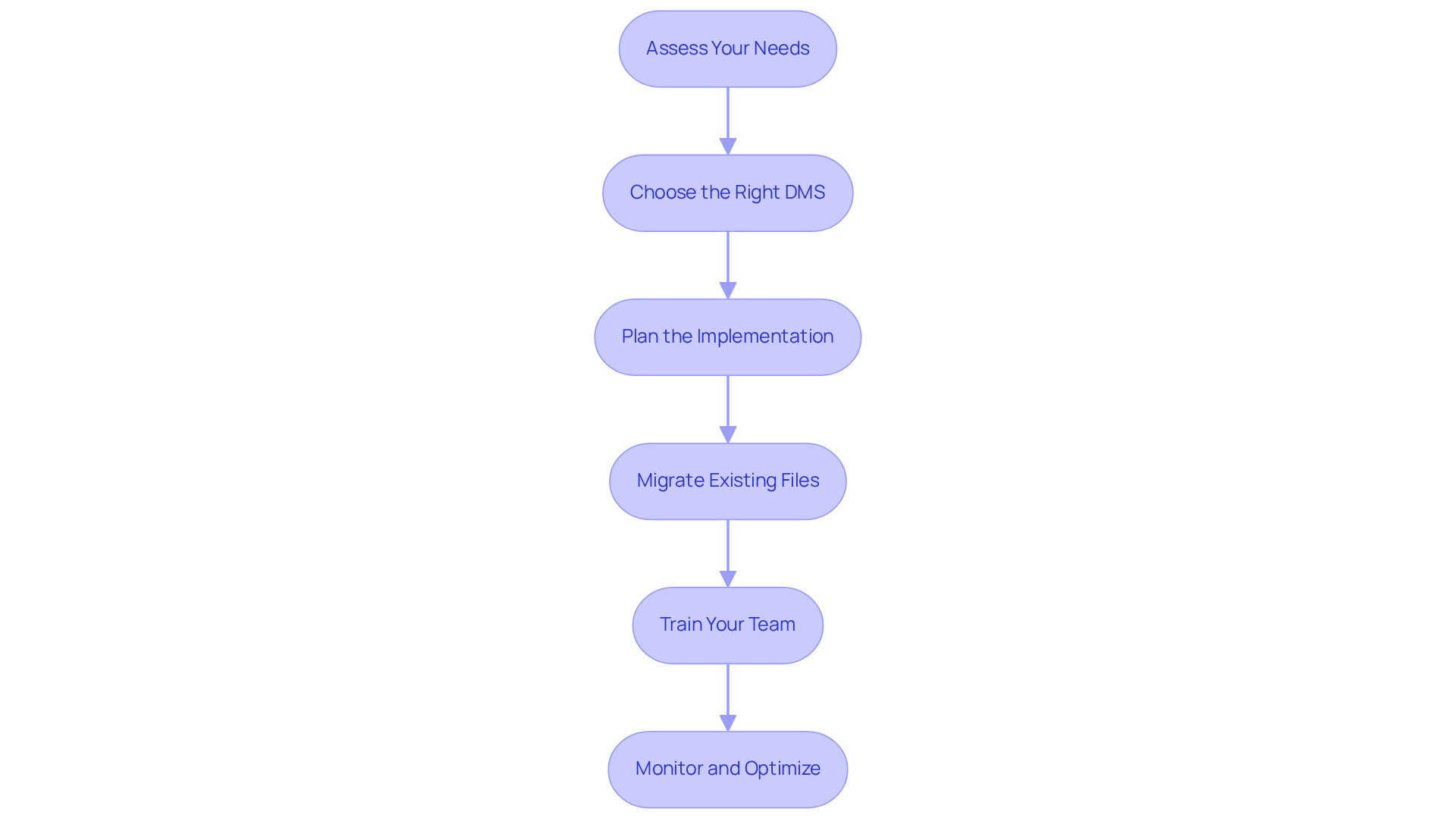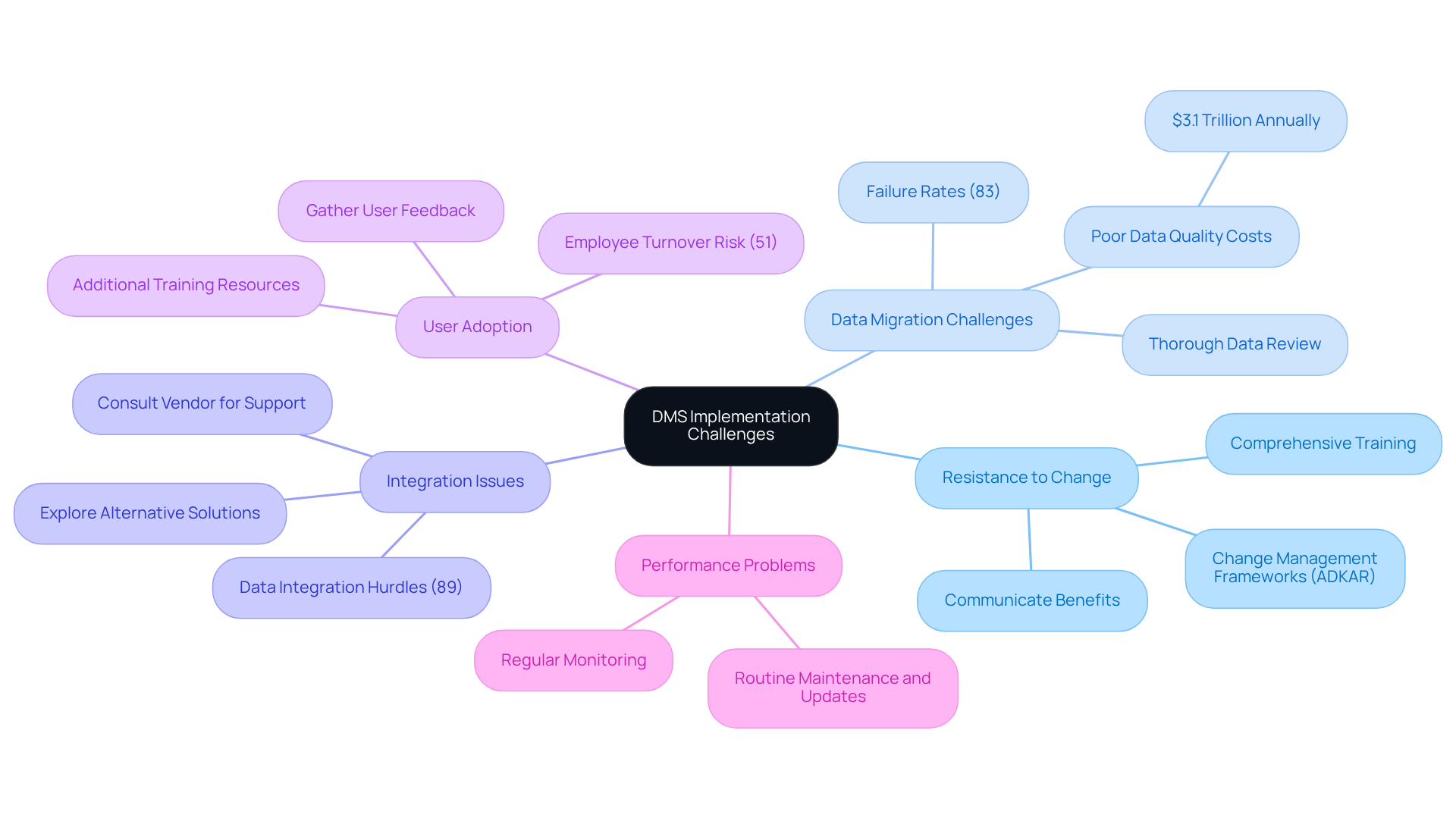Overview
A Document Management Solution (DMS) significantly enhances stakeholder management by improving communication, fostering cooperation, and increasing operational efficiency among all parties involved. This article highlights how a DMS:
- Streamlines access to documents
- Facilitates real-time collaboration
- Automates workflows
Consequently, these enhancements foster transparency and compliance—both of which are essential for effective stakeholder engagement. By implementing a DMS, organizations can ensure that all stakeholders are engaged and informed, ultimately driving better results and stronger relationships.
Introduction
The digital landscape is evolving rapidly; however, a staggering 72% of companies still grapple with hybrid information environments, leading to inefficiencies that hinder progress. Document Management Solutions (DMS) present a transformative opportunity for organizations to streamline operations, enhance stakeholder communication, and foster collaboration.
Yet, the question remains: how can implementing a DMS truly elevate stakeholder management amidst the challenges of integration and user adoption? Exploring this vital connection reveals not only the benefits of improved information accessibility but also the potential for driving sustainable growth in an increasingly competitive marketplace.
Understand Document Management Solutions
A File Management Solution (DMS) stands as a comprehensive system engineered to capture, store, manage, and track electronic files alongside images of paper-based information. By optimizing file handling procedures, a DMS empowers organizations to access, share, and manage their files with both security and efficiency. Key features of a DMS include:
- Document Capture: This process encompasses scanning and digitizing paper documents, transforming them into easily accessible digital formats.
- Storage: A DMS securely retains files in a centralized repository, mitigating the risk of loss and ensuring straightforward retrieval.
- Version Control: This feature diligently monitors revisions and updates, guaranteeing that users consistently access the most current information.
- Access Control: Organizations can effectively manage who can view or edit files, thereby enhancing security and compliance.
- Search Functionality: A DMS facilitates rapid access to files through keywords or tags, significantly reducing the time spent searching for information.
As of 2025, only 28% of small to medium enterprises have advanced their digital transformation for information management, underscoring a significant opportunity for enhancement. Furthermore, 46% of workers at small to midsize businesses waste time on inefficient paper processes each day, highlighting the urgency of adopting a DMS. Implementing a DMS can yield a 21.3% increase in organizational efficiency, alleviating the challenges associated with traditional handling techniques. Industry leaders emphasize that efficient document management not only enhances productivity but also fosters a culture of collaboration within businesses. Additionally, 80% of organizations report that app integration issues impede their digital transformation efforts, presenting a challenge when implementing a DMS. By adopting a DMS, businesses can explore how a document management solution improves stakeholder management, streamlines operations, and ultimately drives sustainable growth.

Identify Benefits for Stakeholder Management
Implementing a Document Management Solution (DMS) significantly enhances stakeholder management through various key benefits:
-
Improved Communication: A DMS streamlines communication by granting stakeholders easy access to pertinent documents, ensuring alignment and clarity across all parties involved. This accessibility is vital, as businesses often squander significant resources—up to $8 billion each year—handling paper records, which can result in miscommunication and inefficiencies. By starting with a thorough business assessment, organizations can better grasp their communication requirements and coordinate involved parties effectively.
-
Improved Cooperation: With real-time collaboration features, participants can work together on files simultaneously, reducing delays and promoting faster decision-making. This collaborative environment is supported by data indicating that employees typically spend only 15% of their time consuming information, while the rest is often wasted searching for it. A DMS tackles this issue by streamlining file retrieval, enabling teams to make decisions quickly and effectively, which is crucial during turnaround processes.
-
Enhanced Clarity: A DMS offers thorough monitoring of file modifications and access, which fosters trust among involved parties. By offering visibility into processes, organizations can ensure that all parties are informed and engaged, reducing the likelihood of misunderstandings. Ongoing observation of materials interactions can also function as a real-time analytics tool to evaluate participant engagement and material effectiveness.
-
Streamlined Processes: Automating paperwork workflows alleviates the burden of manual tasks, allowing stakeholders to concentrate on strategic initiatives rather than administrative duties. This efficiency is crucial, as companies can face expenses of roughly $120 in labor to find a misfiled paper and $220 to recreate a lost item. By identifying underlying issues and planning accordingly, a DMS can help reinforce strengths and mitigate weaknesses in operational processes.
-
Improved Adherence: A DMS assists businesses in upholding regulatory compliance by safely storing files and enabling straightforward access during audits. This capability is essential in avoiding penalties and safeguarding the entity’s reputation, as non-compliance can lead to significant legal and financial repercussions. By continuously monitoring compliance-related documents, entities can ensure they are always prepared for audits and regulatory checks.
In summary, a robust Document Management Solution raises the question of how does a document management solution improve stakeholder management by enhancing communication and collaboration among involved parties, as well as boosting overall operational efficiency, compliance, and transparency. By incorporating real-time analytics and strategic planning into the DMS framework, entities can achieve improved business results and cultivate stronger relationships with interested parties.

Implement a Document Management Solution
To implement a Document Management Solution (DMS) effectively, consider the following steps:
-
Assess Your Needs: Start by determining the particular necessities of your organization and stakeholders concerning management of records. Comprehending these needs is vital, as 72% of companies face challenges with hybrid information environments, complicating access to data. Additionally, 20% of SMBs are unsure where to start with digitization, highlighting the importance of a thorough assessment.
-
Choose the Right DMS: Research and select a DMS that aligns with your needs. Key factors to consider include scalability, user-friendliness, and integration capabilities. A well-selected system can considerably decrease the time workers spend looking for files, which averages around 18 minutes per search, resulting in a possible productivity increase of up to 30%.
-
Plan the Implementation: Develop a detailed implementation plan that outlines timelines, responsibilities, and resource allocation. This structured approach helps mitigate the challenges often faced during transitions to digital workflows.
-
Migrate Existing Files: Organize and digitize current paper records, ensuring they are properly indexed for easy retrieval. Given that 45% of small and midsize businesses still rely on paper records, this step is vital for enhancing efficiency and compliance. Notably, 46% of small businesses reported wasting time daily due to paper-intensive processes, underscoring the urgency of this transition.
-
Train Your Team: Provide comprehensive training for employees and stakeholders on how to use the DMS effectively. Emphasizing the advantages of the system can encourage increased adoption, as 51% of employees aged 18-34 would contemplate leaving their job because of ineffective information management.
-
Monitor and Optimize: After implementation, continuously monitor the system's performance and gather feedback to make necessary adjustments for improvement. Routine evaluations can assist in tackling any inefficiencies, as organizations encounter a 21.3% decline in productivity due to inadequate paperwork procedures. Furthermore, 91% of data professionals say data quality issues hurt company performance, emphasizing the need for ongoing attention to data integrity.
By following these steps, businesses can explore how a document management solution improves stakeholder management through enhanced information accessibility and collaboration, ultimately driving better operational outcomes.

Troubleshoot Common Implementation Issues
Implementing a Document Management Solution (DMS) can present several challenges. Here’s how to effectively address them:
-
Resistance to Change: Employees often resist adopting new technologies. To combat this, clearly communicate the benefits of the DMS, emphasizing how it can streamline operations and enhance productivity. Providing comprehensive training can also alleviate concerns and foster a positive attitude towards the transition. Additionally, adopting change management frameworks like ADKAR can provide a structured approach to overcoming resistance.
-
Data Migration Challenges: Precise digitization and indexing of records are essential. Conduct thorough reviews of migrated data to identify discrepancies, as poor data quality can lead to significant operational inefficiencies. In fact, poor data quality costs U.S. businesses an astonishing $3.1 trillion each year, emphasizing the necessity for careful planning and execution in data migration projects, where 83% of entities encounter failure rates.
-
Integration Issues: If the DMS struggles to integrate with existing systems, consult with the vendor for tailored support. In some cases, exploring alternative solutions that offer better compatibility may be necessary to ensure seamless operations. Notably, 89% of businesses face data integration hurdles, underscoring the importance of addressing these challenges.
-
User Adoption: Low engagement with the DMS can hinder its effectiveness. Actively gather user feedback to understand their concerns and provide additional training or resources as needed. Research indicates that 51% of employees aged 18-34 would consider leaving their job due to inefficient document management, underscoring the importance of user satisfaction and engagement strategies.
-
Performance Problems: Regularly monitor the system for slowdowns or errors. Implementing routine maintenance and updates can help mitigate these issues, ensuring that the DMS operates efficiently and meets user expectations.
By proactively addressing these common implementation issues, organizations can enhance stakeholder management, illustrating how a document management solution improves stakeholder management.

Conclusion
Implementing a Document Management Solution (DMS) is pivotal in enhancing stakeholder management by streamlining communication and collaboration within organizations. This system not only facilitates the efficient handling of documents but also fosters a more transparent and cooperative environment among stakeholders, ultimately driving better business outcomes.
The article highlights several key benefits of a DMS, including:
- Improved communication
- Real-time collaboration
- Enhanced clarity
- Streamlined processes
- Better adherence to compliance standards
By addressing the inefficiencies of traditional document handling methods, a DMS empowers organizations to save time, reduce costs, and maintain regulatory compliance, which is crucial in today’s fast-paced business landscape.
In conclusion, the adoption of a Document Management Solution represents a strategic investment that can significantly transform stakeholder management practices. Organizations are encouraged to recognize the urgency of transitioning to digital workflows and to take proactive steps in implementing a DMS. By doing so, they not only enhance operational efficiency but also build stronger relationships with stakeholders, paving the way for sustainable growth and success.
Frequently Asked Questions
What is a Document Management Solution (DMS)?
A Document Management Solution (DMS) is a comprehensive system designed to capture, store, manage, and track electronic files and images of paper-based information, optimizing file handling procedures for better access, sharing, and management.
What are the key features of a DMS?
Key features of a DMS include document capture, storage, version control, access control, and search functionality.
How does document capture work in a DMS?
Document capture involves scanning and digitizing paper documents, converting them into easily accessible digital formats.
What role does storage play in a DMS?
Storage in a DMS securely retains files in a centralized repository, reducing the risk of loss and ensuring easy retrieval.
What is version control in a DMS?
Version control monitors revisions and updates to documents, ensuring that users always access the most current information.
How does access control enhance security in a DMS?
Access control allows organizations to manage who can view or edit files, thereby improving security and compliance.
What is the significance of search functionality in a DMS?
Search functionality enables rapid access to files using keywords or tags, significantly reducing the time spent searching for information.
What percentage of small to medium enterprises have advanced their digital transformation for information management as of 2025?
As of 2025, only 28% of small to medium enterprises have advanced their digital transformation for information management.
How much time do workers at small to midsize businesses waste on inefficient paper processes each day?
46% of workers at small to midsize businesses waste time on inefficient paper processes each day.
What potential increase in organizational efficiency can be achieved by implementing a DMS?
Implementing a DMS can yield a 21.3% increase in organizational efficiency.
What challenges do organizations face when implementing a DMS?
80% of organizations report that app integration issues impede their digital transformation efforts, presenting challenges when implementing a DMS.
How does a DMS contribute to stakeholder management and sustainable growth?
A DMS improves stakeholder management, streamlines operations, and ultimately drives sustainable growth for businesses.




